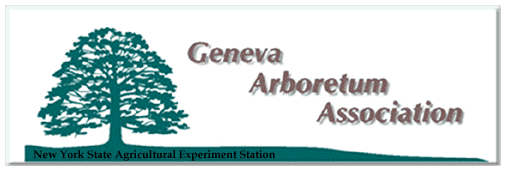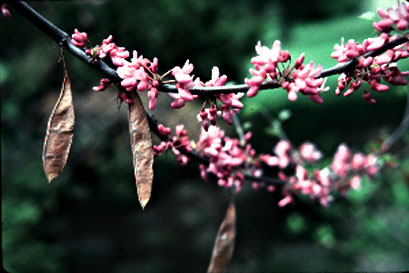

Eastern redbud, Cercis canadensis, is a member of the Leguminosae or Pea family and got its common name, Judas tree, from legend. Biblical literature records that after betraying Christ, Judas Iscariot hanged himself from a tree. Legend contends that he selected a redbud tree (C. siliquastrum, a tree related to our native species but found in western Asia and southern Europe), thus giving rise to the common name "Judas tree." The story goes further to say that the redbud flowers, which were originally all white in color, turned bright pink in shame after the event.
Our native eastern redbud, Cercis canadensis, is a small deciduous
tree found from New York to Florida, and west to Texas. It is short-lived
and grows rapidly on most sites except on heavy clay soils. It will tolerate
sun or shade and occurs naturally as a very common understory tree of the
Northeastern deciduous forest. It is the state tree of Oklahoma. (Do you
know what New York's state tree is?)
C. canadensis may reach 35 feet in height and has a low, spreading,
flat to rounded crown with a short straight trunk. The leaves are broadly
heart shaped with a papery texture and a short point. Redbud's bright lilac
pink to red pea-like flowers appear in clusters along older branches before
the leaves in April or May, and are a welcome herald of spring in many regions.
The flat seed pods are 2-4 inches long and also hang in clusters, containing
several seeds each.
Cultivars are available commercially with white or double flowers. You can
start your own trees by sowing seeds under glass in February or by transplanting
small young plants from the wild. Redbud is used considerably as an ornamental
and is often planted with conifers, which make a handsome contrast in early
spring. A fine example of this can be found in our own Rock Garden, between
Sturtevant Hall and the IPM building where redbuds, both planted and self-sown,
make a beautiful contrast in the spring with the balsam fir, dwarf Norway
spruce and white firs planted near by.
by Martin Goffinet
Next (Dawn Redwood)
Return to Arboretum Home Page
Return to NYS Agricultural Experiment Station Home Page